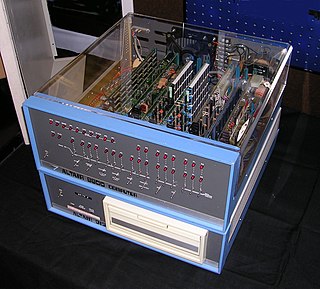
The Altair 8800 is a microcomputer designed in 1974 by MITS and based on the Intel 8080 CPU. Interest grew quickly after it was featured on the cover of the January 1975 issue of Popular Electronics and was sold by mail order through advertisements there, in Radio-Electronics, and in other hobbyist magazines. According to Harry Garland, the Altair 8800 was the product that catalyzed the microcomputer revolution of the 1970s. It was the first commercially successful personal computer. The computer bus designed for the Altair was to become a de facto standard in the form of the S-100 bus, and the first programming language for the machine was Microsoft's founding product, Altair BASIC.

Willy Otto Oskar Ley was a German and American science writer and proponent of cryptozoology. The crater Ley on the far side of the Moon is named in his honor.
Micro Instrumentation and Telemetry Systems (MITS) was an American electronics company founded in Albuquerque, New Mexico that began manufacturing electronic calculators in 1971 and personal computers in 1975.

Model Railroader (MR) is an American magazine about the hobby of model railroading. Founded in 1934 by Al C. Kalmbach, it is published monthly by Kalmbach Media of Waukesha, Wisconsin. Commonly found on newsstands and in libraries, it promotes itself as the oldest magazine of its type in the United States, although it is the long-standing competitor to Railroad Model Craftsman, which - originally named The Model Craftsman - predates MR by one year.
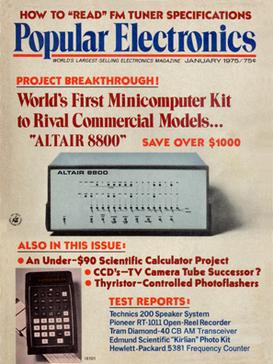
Popular Electronics was an American magazine published by John August Media, LLC, and hosted at TechnicaCuriosa.com. The magazine was started by Ziff-Davis Publishing Company in October 1954 for electronics hobbyists and experimenters. It soon became the "World's Largest-Selling Electronics Magazine". In April 1957, Ziff-Davis reported an average net paid circulation of 240,151 copies. Popular Electronics was published until October 1982 when, in November 1982, Ziff-Davis launched a successor magazine, Computers & Electronics. During its last year of publication by Ziff-Davis, Popular Electronics reported an average monthly circulation of 409,344 copies. The title was sold to Gernsback Publications, and their Hands-On Electronics magazine was renamed to Popular Electronics in February 1989, and published until December 1999. The Popular Electronics trademark was then acquired by John August Media, who revived the magazine, the digital edition of which is hosted at TechnicaCuriosa.com, along with sister titles, Mechanix Illustrated and Popular Astronomy.

Shortwave listening, or SWLing, is the hobby of listening to shortwave radio broadcasts located on frequencies between 1700 kHz and 30 MHz (30 000 kHz). Listeners range from casual users seeking international news and entertainment programming, to hobbyists immersed in the technical aspects of long-distance radio reception and sending and collecting official confirmations that document their reception of remote broadcasts (DXing). In some developing countries, shortwave listening enables remote communities to obtain regional programming traditionally provided by local medium wave AM broadcasters. In 2002, the number of households that were capable of shortwave listening was estimated to be in the hundreds of millions.

Forrest M. Mims III is an American amateur scientist, magazine columnist, and author of Getting Started in Electronics and Engineer's Mini-Notebook series of instructional books that were originally sold in Radio Shack electronics stores and are still in print. Mims graduated from Texas A&M University in 1966 with a major in government and minors in English and history. He became a commissioned officer in the United States Air Force, served in Vietnam as an Air Force intelligence officer (1967), and a Development Engineer at the Air Force Weapons Laboratory (1968–70).

Mechanix Illustrated is an American printed magazine that was originally published by Fawcett Publications. Its title was founded in 1928 to compete against the older Popular Science and Popular Mechanics. Billed as "The How-To-Do Magazine," Mechanix Illustrated (MI) aimed to guide readers through various projects from home improvements and advice on repairs to "build-your-own ." It was headquartered in New York City.
Frederick Charles Judd was a British inventor, amateur radio operator, and proselytiser of early British electronic music.

Henry EdwardRoberts was an American engineer, entrepreneur and medical doctor who invented the first commercially successful personal computer in 1974. He is most often known as "the father of the personal computer." He founded Micro Instrumentation and Telemetry Systems (MITS) in 1970 to sell electronics kits to model rocketry hobbyists, but the first successful product was an electronic calculator kit that was featured on the cover of the November 1971 issue of Popular Electronics. The calculators were very successful and sales topped one million dollars in 1973. A brutal calculator price war left the company deeply in debt by 1974. Roberts then developed the Altair 8800 personal computer that used the new Intel 8080 microprocessor. This was featured on the cover of the January 1975 issue of Popular Electronics, and hobbyists flooded MITS with orders for this $397 computer kit.
Amateur rocketry, sometimes known as experimental rocketry or amateur experimental rocketry, is a hobby in which participants experiment with fuels and make their own rocket motors, launching a wide variety of types and sizes of rockets. Amateur rocketeers have been responsible for significant research into hybrid rocket motors, and have built and flown a variety of solid, liquid, and hybrid propellant motors.

Daniel Meyer was the founder and president Southwest Technical Products Corporation. He was born in New Braunfels, Texas, and raised in San Marcos, Texas, where he earned a bachelor's degree in mathematics and physics in 1957 from Southwest Texas State. After college he married Helen Wentz, moved to San Antonio and became a research engineer in the electrical engineering department of Southwest Research Institute.
Electronics Today International or ETI was a magazine for electronics hobbyists and professionals.
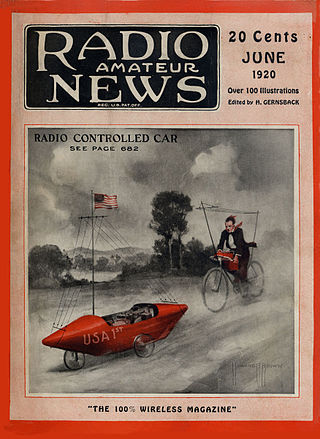
Radio News was an American monthly technology magazine published from 1919 to 1971. The magazine was started by Hugo Gernsback as a magazine for amateur radio enthusiasts, but it evolved to cover all the technical aspects to radio and electronics. In 1929, a bankruptcy forced the sale of Gernsback's publishing company to B. A. Mackinnon. In 1938, Ziff-Davis Publishing acquired the magazines.

Hands-On Electronics was an electronics hobbyist magazine published by Gernsback Publications in the United States from 1980 to 1989.

Model Rocketry was an American hobbyist magazine published from October 1968 to February 1972. The Editor and Publisher was George J. Flynn and the Managing Editor was Gordon K. Mandell. Other members of the editorial and business staffs, some of whom held several positions at various times during the years the magazine was published, were Assistant Editors Robert B. Singer and Robert Parks ; Technical Editor Douglas J. Malewicki ; Business Managers George J. Caporaso, Jerome Apt, III, Thomas T. Milkie, and Arthur H. (Trip) Barber ; Technical Correspondent George J. Caporaso ; Distribution Managers Thomas T. Milkie, Kevin P. Brown, and Steven Glines ; and Art Director Thomas T. Milkie. The magazine was published by Model Rocketry, Inc., a closely held corporation owned by founding staff members George J. Flynn, Gordon K. Mandell, George J. Caporaso, and Thomas T. Milkie and members of their families. Its paid circulation reached 15,000 by 1970.
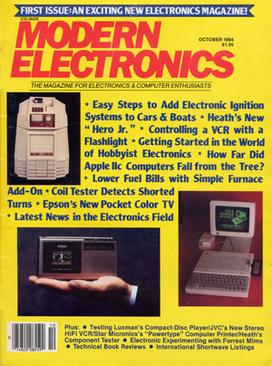
Modern Electronics was a hobbyist magazine published from October 1984 to March 1991. It became Computer Craft in April 1991 and the name changed again to MicroComputer Journal in January 1994. Modern Electronics, Inc. was owned by CQ Communications, Inc, the publishers of CQ Amateur Radio.
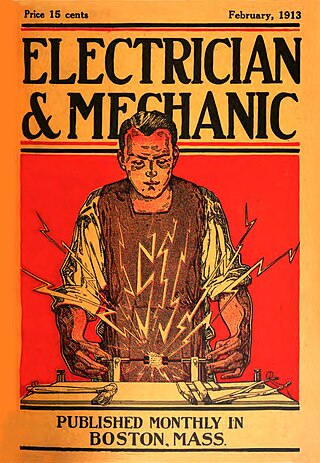
Electrician and Mechanic was an American science and technology magazine published from 1890 to January 1914 when it merged with Modern Electrics to become Modern Electrics & Mechanics. In July 1914, incorporated with Popular Electricity and the World's Advance and the title became Popular Electricity and Modern Mechanics. The new publisher, Modern Publishing, began a series of magazine mergers and title changes so numerous that librarians began to complain. In October 1915 the title became Popular Science Monthly and the magazine is still published under that name today.
Electronics World is a technical magazine in electronics and RF engineering aimed at professional design engineers. It is produced monthly in print and digital formats.

Byte was a microcomputer magazine, influential in the late 1970s and throughout the 1980s because of its wide-ranging editorial coverage.















